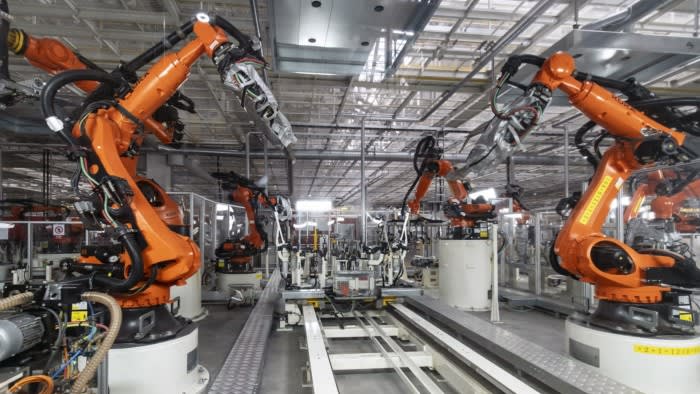Unlock the Editor’s Digest for free
Roula Khalaf, Editor of the FT, selects her favourite stories in this weekly newsletter.
In March, as a visiting delegation of Swedish investors and bankers passed through China’s factories and shipyards for the first time since the pandemic, what they witnessed was a shock to their systems.
Across the mainland, where Sweden’s manufacturers have a long-standing presence, competition from Chinese firms was “ferocious”, even “monstrous”, according to Mattias Sundling, chief equity strategist at Handelsbanken. “The way they have caught up and developed in just two or three years was just stunning to us,” he said. “The cliched image of Chinese competition was one of cheap copies. I think the wake-up call for us when we were on this trip is that this is no longer the case.”
From high school examinations to bubble tea franchises, intense domestic competition is pervasive across China. Now, as embodied in expanding electric-vehicle production, that sense of competition poses a growing challenge to international businesses.
Autos are just one part of a wider industrial framework within which, for decades, developed economies have relied on China as an inexpensive and collaborative manufacturing hub. The Swedish presence includes giants such as Atlas Copco, the world’s leading provider of air compressors, and Sandvik, which makes mining equipment.
An air of collaboration, especially at foreign companies now largely staffed by Chinese nationals, has not disappeared. But it is now accompanied by mounting competitive pressure. “The general take is if you are not a premium product, you are getting absolutely hammered,” said Sundling.
Governments in the US and Europe have focused heavily on the need to “de-risk” supply chains away from China after Russia’s invasion of Ukraine and border closures under the pandemic. But the more competitive the mainland becomes, the harder it is for international industrial players to leave. At the end of 2020 Volkswagen opened a research and development centre in Anhui province, and owns a major stake in Guoxuan, a Chinese battery firm.
Both old and new industrial companies repeatedly emphasise the need to be in China for research purposes as well as to access its vast market. Windrose Technology, an electric truck start-up that has so far produced 13 vehicles, aims to eventually list in the US but currently relies on mainland China partners, including state-owned Anhui Jianghuai Automobile Group, for manufacturing.
“As an EV maker, if you are not linked to China and you pretend to be the world’s best truck in the EV space, no one’s going to believe you,” said Wen Han, Windrose founder. “If I told people I was an Australian EV start-up, people would just probably not believe me. If I told people I’m a British EV start-up, they would also not believe me.”
While China is in some respects a hotbed of competition, the nature of its industrial model differs profoundly from the US and Europe. The need for so-called “high quality development” is part of a top-down approach set out in the 2025 “Made in China” policy and has become President Xi Jinping’s main refrain in the past year.
This week, the European Commission updated a 2017 policy document on Chinese trade distortions that identifies various areas, such as energy and finance, in which competition is suppressed both domestically and for any foreign firms hoping to expand.
But the report also touches on competition with Chinese characteristics. In China, it notes, “the provinces and the main cities appear to be in competition among them to have [electric-vehicle] producers in their area, in order to attract employment, revenues and the attention of the central government”.
The role of the state in China is difficult to easily map on to transparently-codified norms in western economies. Chinese companies do not typically engage with questions on their relationship to the government, but, as the EU report establishes over 700 pages, those relationships are widespread.
If competition with Chinese companies rises further, so will political scrutiny of China’s relationship with international trade. But, across Europe and the US, businesses are already rushing to upgrade their understanding of the nature of that competition.
On the Swedish trip, most of the participants did not even directly invest in China but felt they needed to attend because of their holdings on the domestic stock market.
“Nordic companies, particularly in manufacturing, have a huge exposure, directly or indirectly,” says Sundling. “The minute we got back . . . we’ve been absolutely swamped with conversations and meetings.”
thomas.hale@ft.com

